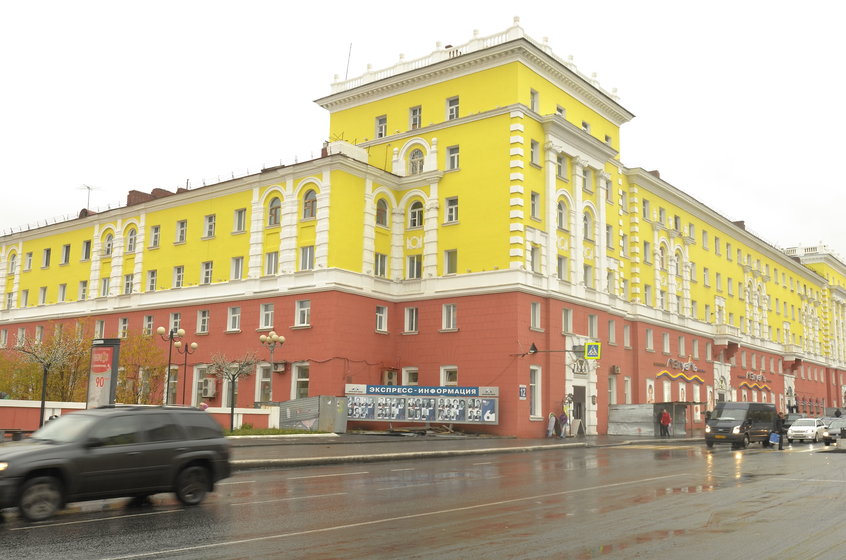Russian cities built on the vast permafrost layer that covers the north of the country are at risk of becoming “unstable” by the middle of this century, according to a research paper published in the Geographical Review.
The authors of the report, which was conducted jointly by the St Petersburg State Hydrological Institute and George Washington University, estimate that the degree of destabilisation depends on climate forecast models, which allow a wide range of outcomes for global warming.
Undetected sewage and water leaks, reduction in centralised snow removal, and violation of construction codes contributed to further warming of permafrost below the foundations during 1990s in Norilsk, resulting in serious deformation of many structures– Report by St Petersburg State Hydrological Institute and George Washington University
If temperatures follow the most conservative estimates, the degree of thaw will not harm most well-engineered structures. If, on the other hand, warming follows a worst-case scenario, there will be a 75-95% reduction in bearing capacity throughout the permafrost region by 2050. “This can have a devastating effect on cities built on permafrost,” the authors warn.
The report notes that numerous studies of climate change up to now show that the Russian Arctic is warming at a rate of 0.12°C a year, “significantly faster than the global average”.
The Soviet Union made great efforts to develop the mineral potential of northern Russia, and founded a number of large urban centres. In some Arctic provinces, 88% of the population live in cities, some of which are continuing to grow.
The standard Soviet approach to urban construction in the 1960s and 1970s was to build six-to-nine-storey structures on 10m deep concrete piles with an air gap between the building and the permafrost. This was intended to insulate the ground from heating systems and prevent serious thawing. However, the solution will not be sufficient to prevent buildings from deforming and collapsing if the mean temperature rises above a certain point.
Four case studies
The researchers looked in detail at four Arctic towns and cities in which more than half of all multifamily dwellings were built in the 1960s and 1970s. These were Anadyr, Salekhard, Norilsk and Yakutsk. They then took the average forecasts of six climate models and looked at how soon each of the settlements would be affected.
The conclusion was that Anadyr, the smallest of the four with a settlement of about 15,000 in Russia’s extreme northeast Chukotka region, was likely to begin experiencing significant instability around in the next few years.
For Salekhard, an isolated town of about 40,000 at the extreme north of the Ural mountains, is likely to show signs of instability by the mid-2020s.

Norilsk is the second largest city in the Arctic Circle after Murmansk – and one of the most polluted (Bizoni/Creative Commons)
Salekhard experienced a more unusual consequence of global warming last year, when temperatures rose to 35°C and caused a release of anthrax, which killed a nomadic herder and many reindeer.
Norilsk is the world’s northernmost city with a population of more than 100,000, where the mean daily temperature rises above zero only between June and September. This is predicted to remain stable until the 2040s, although the situation has been complicated by the area’s high pollution levels, which can increase the salinisation of soil, thereby increasing its freezing point, while at the same time corroding concrete foundations.
Yakutsk, a major centre with a population of 270,000 in eastern Siberia, is the coldest city on earth. This is the main city at risk in terms of asset value although, as with Norilsk, no significant effects are expected before 2040. However, it is one of the most vulnerable: a 2007 study by Lev Khrustalev, a permafrost expert at Moscow State University, estimated that a 1.5°C increase in mean annual air temperature could trigger the deformation of almost all foundations in the city.
What is to be done?
The report recommends that the ground engineering of new construction in permafrost zones be carried out with thaw resistance in mind.
It also underlines the need for permafrost monitoring, better building maintenance, the prompt detection and fixing of water leaks, reduction in industrial pollution and the strict enforcement of building codes.
The collapse of the Soviet Union in 1990 also led to problems owing to a fall in the maintenance of infrastructure and the abandonment of standardised permafrost monitoring. The report adds that “undetected sewage and water leaks, reduction in centralised snow removal, and violation of construction codes contributed to further warming of permafrost below the foundations during 1990s in Norilsk, resulting in serious deformation of many structures”.
It adds that previous academic analysis by Russian scientists has identified leaking utility pipes as a “major cause of bearing capacity loss resulting in significant building deformations throughout the Russian permafrost region”.
Top image: The port of Anadyr may experience instability in the next few years (Creative Commons)






